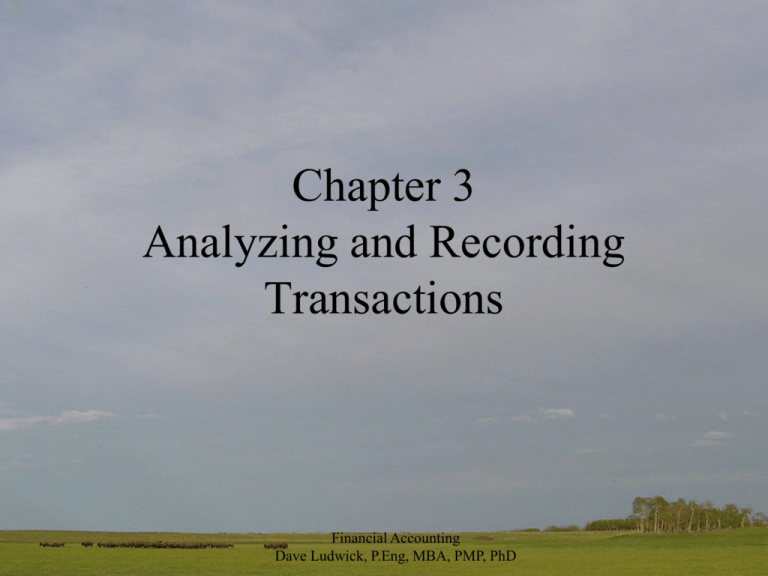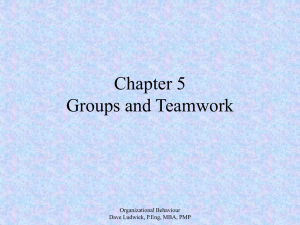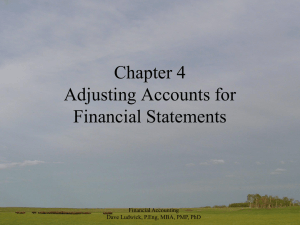Financial Accounting Chapter 3
advertisement

Chapter 3 Analyzing and Recording Transactions Financial Accounting Dave Ludwick, P.Eng, MBA, PMP, PhD The Accounting Cycle • These are the steps followed in preparing financial statements • It is called a cycle since it repeats itself in every accounting period • Chapter 3 covers the white boxes and Chapters 4 and 5 cover the purple boxes Financial Accounting Dave Ludwick, P.Eng, MBA, PMP, PhD Accounts • An account is a detailed record of increases and decreases in a specific asset, liability, equity, revenue or expense item • Separate accounts are kept for each type of asset, liability, equity, revenue or expense item. • Balance Sheet accounts (like cash, AR, AP, etc) are “As at” accounts, showing the status of these items at the end of a period • Income Statement accounts are “flow through” accounts, measuring the amount of revenue and expense occurring through a period • A Chart of Accounts or Ledger is a list of all the accounts used by a company, often showing an account number Financial Accounting Dave Ludwick, P.Eng, MBA, PMP, PhD Assets • Assets are resources available and controlled by the organization for current or future benefit • Assets – Cash, the most liquid of all assets – Accounts Receivable: amounts owed to the company for goods or services provided through operations – Prepaid Expenses, advanced payments made for expenses. Prepaid expenses are assets until the asset is consumed (insurance, rent) – Equipment, are assets not sold in the course of operations, but used to deliver products or services (computers, desks, machinery) over the course of several accounting periods – Buildings and Land are assets because they provide a location in which to operate the business Financial Accounting Dave Ludwick, P.Eng, MBA, PMP, PhD Liabilities • Liabilities are obligations to transfer assets or provide services to other entities. • Liabilities – Accounts Payable: Money owed to suppliers for products or services bought on credit – Unearned Revenue, when customers pay in advance for products or services. – Wages, amounts owed to employees for services provided, but for which they have not yet been paid – Taxes payable, amounts owed to governments for sales tax or income taxes accumulated but not yet paid. – Mortgages or loans, money owed to lending institutions or individuals for money they have loaned to the organization Financial Accounting Dave Ludwick, P.Eng, MBA, PMP, PhD Equity Accounts • There are 4 types of accounts affecting Owner’s Equity: – Owner Capital: records owner investment – Owner Withdrawals: records their withdrawals from investment – Revenues and Expenses • Incurred over a defined period of time • The difference between revenue and expenses defines net income which is either paid out as dividends (after taxes are applied) or rolled back into the organization (often called Retained Earnings) Financial Accounting Dave Ludwick, P.Eng, MBA, PMP, PhD T-Account • We have been using these in our sample problems so far • It is a helpful tool to help illustrate how the various business transactions affect the various accounts and how they relate to each other • The left side is always labeled debit and the right, credit • Depending on which side of the balance sheet the account in question is on, entries on either the right or left could be increases or decreases for that account. Account Title Debit side Credit Side Financial Accounting Dave Ludwick, P.Eng, MBA, PMP, PhD Double Entry Accounting • The most common way to keep accounting records • Means that for every business transaction, there is an affect and a record written into at least 2 accounts to always ensure that the accounting equation is in balance • Rules to remember: – Increases to assets are debited (entered on left side) of asset accounts. Decreases are credited (entered on right side) – Increases in liabilities are credited (entered on right side) to liability accounts. Decreases are debited (entered on left) – Increases in owner’s equity are credited (right side) and decreases are debited left side) – Revenues (or increases in revenues) are credited to revenue accounts, expenses (or increases) are debited to expense accounts • Illustrate: A sale is made for cash, hydro expense paid, cash is used to buy inventory Financial Accounting Dave Ludwick, P.Eng, MBA, PMP, PhD Organizing Accounts • A ledger is a collection of all accounts on the books • A Chart of Accounts is a numeric list of accounts • Some accounting systems and accountants are familiar with an account numbering system • In general the first digit provides a clue to the type of account with subsequent digits providing further detail Financial Accounting Dave Ludwick, P.Eng, MBA, PMP, PhD Analyzing Transactions • Analyzing Transactions is Step 1 in the Accounting Cycle • Lets review the first 15 activities of Vertically Inclined – Review each transaction for their effects on the accounts – Lets see if we can build the Ledger outlined in Exhibit 3.9 (without looking…..hey, no peeking…. Yes, that means you in the red) Financial Accounting Dave Ludwick, P.Eng, MBA, PMP, PhD Journal Entries • We have already been doing these, this is Step 2 in the Accounting Cycle • Consists the following info: – – – – Date of transaction Titles of the affected accounts Dollar amount of each debit or credit Transaction explanation for future reference • Double entry accounting requires that every transaction will affect at least 2 accounts. – Those that affect 3 or more accounts are called Compound Journal Entries • Note that the accounts involved do not need to be on opposite sides of the balance sheet – Ex: A cash purchase of furniture vs. purchase of furniture on credit Financial Accounting Dave Ludwick, P.Eng, MBA, PMP, PhD Journal Entries Date Account Titles and explanation Jan 1 Cash D. Ludwick, Capital Jan 3 Furniture 101 10000 600 1200 1200 125 2000 101 1000 500 Financial Accounting Dave Ludwick, P.Eng, MBA, PMP, PhD Credit 10000 101 Jan 7 Accounts Receivable Revenue Debit 150 Cash Cash PR 3000 Journal Entries • Date column: the transaction date • Account title and explanation: the names of the accounts affected by the transaction. Some journal entries place a short, plain-english, description of the transaction so the record keeper remembers the event • PR: Posting Reference column: a place to enter the account number if accounting number is being applied to the books • Debit and Credit columns: Places to enter the amounts affecting the specific account for the transaction Financial Accounting Dave Ludwick, P.Eng, MBA, PMP, PhD Posting Journal Entries • Step 3 in the Accounting Cycle • The process of posting or transferring entries from the journal to the ledger • Exhibit 3.13 shows a sample posting Financial Accounting Dave Ludwick, P.Eng, MBA, PMP, PhD Trial Balance • Step 4 in the Accounting Cycle • A trial balance is run to simply check whether debits and credits balances • It is a useful summary for understanding how the business transactions affected accounts during the period • Also makes the creation of the Balance Sheet, Income Statement and Statement of Owner’s Equity easier Financial Accounting Dave Ludwick, P.Eng, MBA, PMP, PhD Trial Balance • 5 Steps to a care-free trial balance – Identify account balances either from the ledgers or from the Taccounts – List each account, in the same order of as the Chart of Accounts (usually asset accounts come first, followed by liability accounts, then Owner’s Equity accounts), and their debit or credit sums – Add up all the debits – Add up all the credits – Make sure they equal • Now for the moment you’ve all been waiting for……. Financial Accounting Dave Ludwick, P.Eng, MBA, PMP, PhD Demonstration Problem • Lets try the Demonstration Problem. Lets create a – – – – Balance Sheet, Income Statement, Statement of Owner’s Equity and Cash Flow Statement • Along the way, – journalize all the transactions – Summarize them into T-account entries – Create a trial balance • This is a representative question for the Mid-term exam Financial Accounting Dave Ludwick, P.Eng, MBA, PMP, PhD Onward…. • Good sample problems to try are: – Problems 3-2A, 3-3A, 3-6A, 3-11A • Chapter 4 Financial Accounting Dave Ludwick, P.Eng, MBA, PMP, PhD











